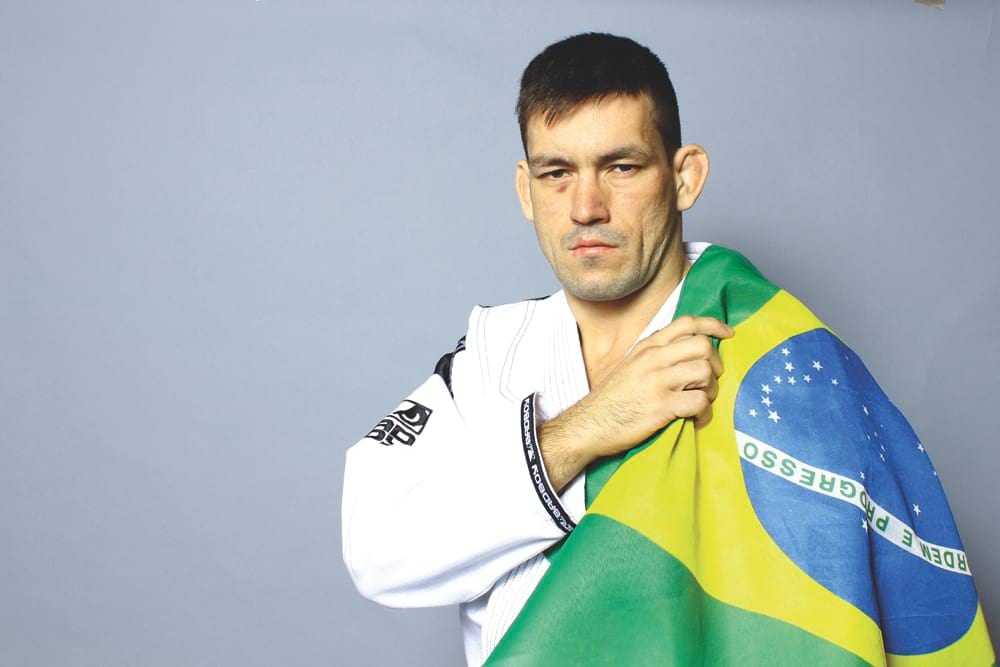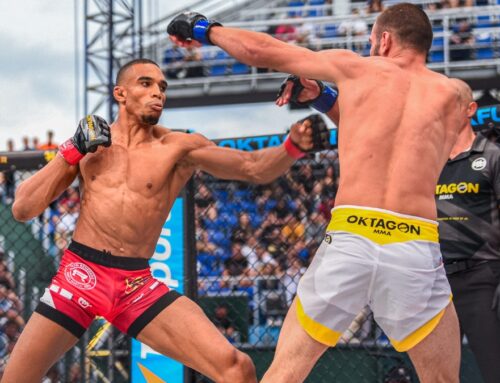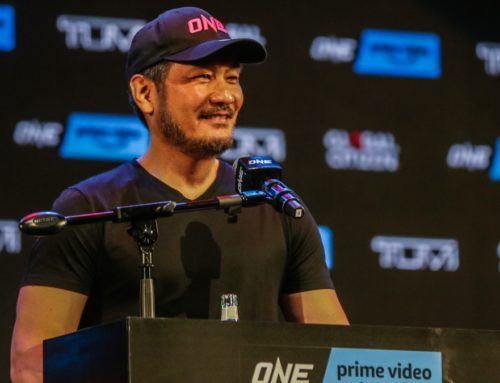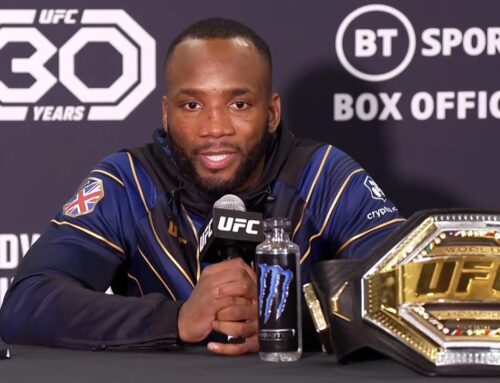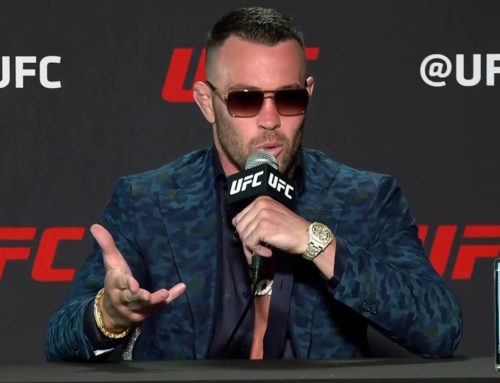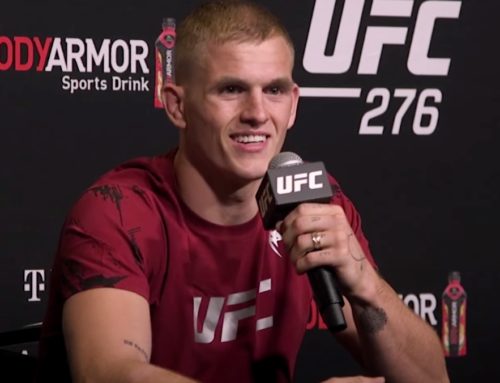The irony of Tyron Woodley questioning the strategy behind Demian Maia’s decision to fight Jorge Masvidal this Saturday (May 13) at UFC 211 won’t be lost on anyone familiar with the Brazilian’s cerebral approach to mixed martial arts. As thoughtful and deliberate as any fighter in the game, Maia thinks two or three moves ahead of the opposition, at least when competing in the Octagon, and isn’t the type to do stuff on a whim, much less with any degree of recklessness. Yet Woodley, the current UFC welterweight champion, can apparently see no logic in Maia’s decision to take a fight with Masvidal when on the cusp of a shot at his belt. It is, he says, the mother of all banana skins, a stylistic nightmare, a fight he apparently cannot win. Dumb.
The reasons for Woodley’s comments are manyfold. Firstly, he trains with Masvidal, so will understandably side with and fancy the Floridian’s chances in the upcoming fight. He also knows how dangerous ‘Gamebred’ is in 2017, buoyed by back-to-back stoppages of Donald Cerrone and Jake Ellenberger, and has even gone so far as to say he is one of the three best boxers in MMA and nigh on impossible to take down. Furthermore, Woodley has seen the improvements in Masvidal since he stopped cutting weight to make lightweight and relaxed into the 170-pound division. He has noticed the difference. He has, in sparring, felt the difference. Most of all, though, Woodley questions Maia’s fight with Masvidal because he sees no upside for the rampaging Brazilian should he win. Get the win, he says, and it will merely be considered a win against a man with a ‘decent but not exceptional’ resume as a lightweight. High risk, low reward.
For anyone else, of course, Masvidal would be deemed not only a serious challenge but a notable scalp. ‘Gamebred’, after all, is in the form of his life and last time out scored one of the wins of 2017 when lassoing a ‘Cowboy’. But Maia, at this point, isn’t anyone else. He’s arguably the leading welterweight contender in the world and has defeated – working backwards – Carlos Condit, Matt Brown, Gunnar Nelson, Neil Magny, Ryan LaFlare and Alexander Yakovlev. That’s six in a row.
The Demian Maia we watch today is the best Demian Maia there has ever been, despite the fact he turns forty this year. He has matured. He has confronted and accepted his flaws. What’s more, he has momentum – tons of it. This isn’t the Maia who grapple-struck his way to a UFC middleweight title shot against Anderson Silva. Nor is it the Maia who strike-grappled his way to a series of post-Silva decisions – some wins, some defeats – and seemed stuck between launching punches and takedowns. Instead, this Maia is one who has seen all there is to see in the Octagon – the good, the bad and the ugly – and used all his experiences and knowledge of what he can and can’t do to refine a machine previously held back by crossed wires. He has aborted the striking mission, while retaining enough of it to keep opponents honest, and has taken to his jiu-jitsu, his calling card, with renewed gusto and vigour, much to the horror of the welterweight division. You see, when Maia grapples, he wins. More or less. He’s that good down there, that damn terrifying for anyone not on his level (which is to say every 170-pound fighter on the planet).
“My biggest inspiration growing up was undoubtedly the Gracies,” the Sao Paulo-native told me. “I used to watch all the Gracie family win and display Brazilian jiu-jitsu to the world. It made me think I could do it, too.
“I did judo when I was four or five years old. I also did kung-fu, karate and then Brazilian jiu-jitsu during my teenage years. Since I was a little kid, I’d always wanted to be a jiu-jitsu fighter. That was my art and my passion. But I also knew my goal would arrive in mixed martial arts. Sport jiu-jitsu was always just a way to practice my skills, whereas mixed martial arts was the real competition for me.”
Maia’s jiu-jitsu credentials are pretty much unparalleled in mixed martial arts. The second degree black belt is a three-time World Cup champion, a two-time World Champion, 2006 Pan-American champion, 2007 ADCC (Abu Dhabi Combat Club) champion, seven-time state champion and four-time Brazilian team champion. He even has a jiu-jitsu victory over Gabriel Gonzaga. Yes, that Gonzaga. The heavyweight Gonzaga.
“When I first got started in MMA I quickly realised I could use my jiu-jitsu in the sport. I wasn’t sure whether it would work to begin with, but it wasn’t long before I started seeing it was fairly easy to adapt.
“Of course, there are slight differences between competition jiu-jitsu and MMA jiu-jitsu, but I didn’t find it difficult taking my game into mixed martial arts. I didn’t need to change much and it was pretty easy to adapt and make it fit in with MMA. It’s hard work for someone starting out, but if you truly like MMA it’s easy to make the transition.”
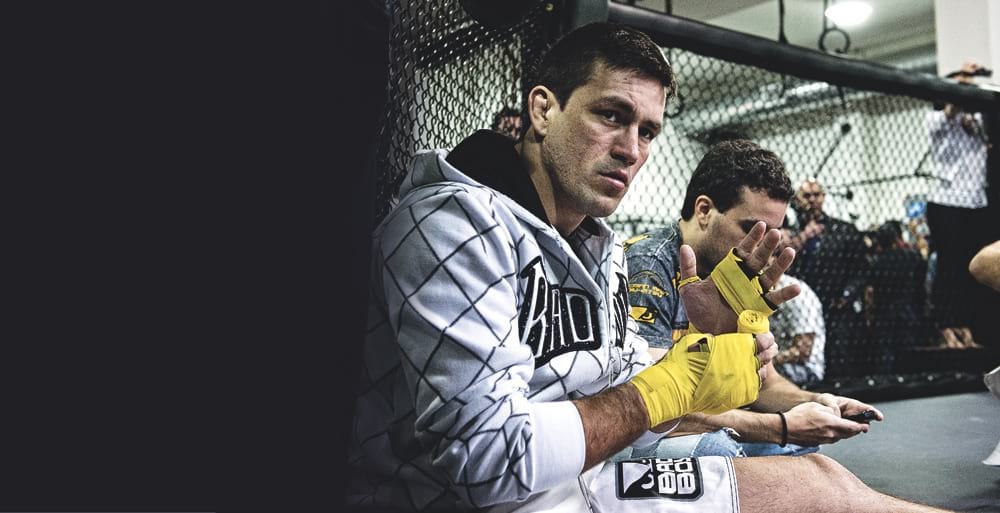
The transition. This, for Maia, occurred as a middleweight. It occurred when he was loose and fleshy around the midriff and when prone to shying away from incoming punches. It was a transition in every sense of the word. Arduous, complicated, confusing, Maia, in adapting, moved away from his world-class jiu-jitsu and focused more on a discipline – striking – that not only seemed unnatural but inadvertently distanced him from his first love.
“I think the striking element will eventually come naturally to me, but it will take time,” Maia said to me during his middleweight run in 2009. “I train striking a lot now and do a lot of stand-up fights, like boxing and Muay-Thai, to try and improve my all-round game. I’m not in a rush to get my striking to a certain level, though. I don’t feel in a panic. I’m not the kind of guy who will train boxing and punching every day and do it non-stop. I train stand-up at least three or four times a week.
“The beauty of mixed martial arts is that the fighters offer something different and the fans can cheer whichever style they prefer. I’m not going to knock people out like Chuck Liddell, of course, but I think a lot of jiu-jitsu fans like my style and the way I finish fights.
“Although I’m a jiu-jitsu guy, I’m not afraid to stand and throw punches. I also don’t just lie on my opponent and not advance position. I try to be aggressive with my jiu-jitsu and always look for submission opportunities.”
In hindsight, it’s only when Maia neglects his grappling that he seems to be in any danger whatsoever; danger of being hurt, danger of losing. Keep it down there, in his comfort zone, and it’s a banker home win. If kept standing, however, you have a chance. Maia has discovered this the hard way over the years. Nate Marquardt, for instance, introduced him to the art of power-punching in 2009, halting him in round one, while others have managed to keep Maia upright and at bay and exploit the perks of superior striking technique en route to a decision win.
Whether hurt or frustrated, Maia for a while knew something wasn’t right. He knew it – this striking, this thing he was told to improve – wasn’t necessarily going to win him fights. It was important, people told him, for it would make him more well-rounded, more dangerous. It would enable him to hurt opponents the old-fashioned way. But the truth was that Demian Maia was never more damaging and never more hurtful than when he was off his feet and exhibiting what he and many others call the ‘peaceful art’.
“A lot of jiu-jitsu is based around the idea of not hurting people,” said Demian. “Jiu-jitsu gives people an option to tap or submit. The intention is not to hurt or punish the opponent. They are given a choice to stop that. That’s what I try and do in my fights. I try and represent jiu-jitsu to the best of my ability and show the philosophy of the art. I don’t like to hurt people.”
In Jorge Masvidal, 32, Maia is set to meet his complete antithesis. He is about to meet a man who would rather stand and bang than go to the ground and hang – be it in someone’s guard or on top. He is about to meet a street-fighter who is no respecter of reputations, a street-fighter who, for better or worse, will snarl in the face of Maia’s jiu-jitsu pedigree and penchant for taking down opponents and making them squirm and then submit. Maia knows this just as Tyron Woodley, the UFC welterweight champion, knows this; one overlooks these differences, these dangers, figuring they won’t be a factor in the fight, while the other feels these same stylistic differences stand to wreck everything Maia has worked so hard to achieve in the last three years.
Still, just as Jorge Masvidal is the antithesis to Demian Maia, it could be argued Demian Maia is the antithesis to near enough every other top contender in the UFC right now. Asked about title shots, he shrugs it off; it will happen when it’s meant to happen, he will say. Asked to fight fellow contenders, he accepts. Asked why he has agreed to face Masvidal, meanwhile, and he will simply call it a ‘number one contender fight’ and say Woodley, the critic, doesn’t know the ins and outs of the situation.
Praise the approach. While many choose to go AWOL and campaign or complain, thus making a mockery of a division’s hierarchy and schedule, it’s refreshing to see a 39-year-old grappler they said couldn’t fight now showing an unquenchable thirst to do just that – fight. Better still, now doing it his way, on his terms, when he wants and how he wants.

